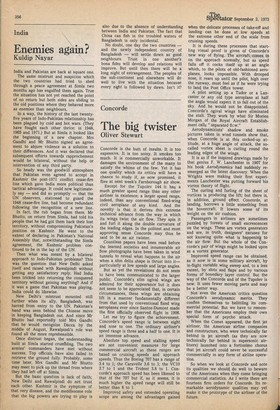Concorde
The big twister
Oliver Stewart
Concorde is the butt of insults. It is too expensive. It is too noisy. It smokes too much. It is commercially unworkable. It damages the environment of the many to satisfy the whims of the few. Yet it has one quality which its critics will have a chance to study if, as now promised, it flies at next week's Farnborough air show.
Except for the Tupolev 144 it has a much greater speed range than any other airliner in existence; a larger speed range, indeed, than any conventional fixed-wing civil aeroplane of any kind. And the novelty is that it derives this extreme technical advance from the way in which its wings twist the air flow. They spin it and furl it along the double curvature of the leading edges. In the politest and most approving sense Concorde may thus be said to be an air twister.
Countless papers have been read before the learned societies and innumerable air flow photographs have been taken in wind tunnels to reveal what happens to the air when a slim delta shape is thrust into it— particularly at low speeds and large angles.
But as yet the revelations do not seem to have been communicated to the larger public. Concorde's slim ogival wings are admired for their appearance but it does not seem to be appreciated that, in certain circumstances, these wings are obtaining lift in a manner fundamentally different from that used by conventional fixed wing aeroplanes ever since Santos-Dumont made the first officially observed flight in 1906.
Let me try to figure the achievement. Concorde's speed range is between eight and nine to one. The ordinary airliner's speed range is three and a half to one. It is an immense advance.
Absolute top speed and stalling speed are not convenient measures for large commercial aircraft so these ranges are based on cruising speeds and approach speeds. Thus the Boeing 707 has a range of 3.4 to 1; the Caravelle 3.6 to 1; the VCIO 3.7 to 1 and the Trident 3.8 to 1. Concorde's approach speed has been likened to that of the 707 but if, as it seems, it is much higher the speed range will still be better than 8 to 1.
Improved safety and extended operating scope are among the advantages gained when the delicate processes of take-off and landing can be done at low speeds at the extreme other end of the scale from cruising speeds.
It is during these processes that startling visual proof is given of Concorde's new way of flying. The aircraft comes in on the approach normally, but as speed falls off it cocks itself up at an angle which, to the pilots of old-fashioned aeroplanes, looks impossible. With drooped nose, it rears up until the pilot, high over the runway, must feel as if he were trying to land, the Post Office tower.
A pilot setting up a Tudor or a Lancaster or any old type aeroplane at half the angle would expect it to fall out of the sky. And he would not be disappointed. Concorde's ogival wings have eliminated the stall. They work by what Sir Morien Morgan of the Royal Aircraft Establishment calls " separated flcw."
Aerodynamicists' shadow and smoke pictures taken in wind tunnels show that, when Concorde is at this cocked-up attitude, at a huge angle of attack, the socalled vortex sheet is curling round the leading edges of the wings.
It is as if the inspired drawings made by that genius F. W. Lanchester in 1907 for his book Aerodynamics had suddenly reemerged as the latest discovery. When the Wrights were making their first experiments Lanchester was putting forward his vortex theory of flight.
The curling and furling of the sheet of vortices is producing the lift; but there is, in addition, ground effect. Concorde, at landing, borrows a little something from the hovercraft. It lowers some of its weight on the air cushion.
Passengers in airliners are sometimes puzzled by forests of small excrescences on the wings. These are vortex generators and are, in truth, designers' excuses for not knowing quite what is happening to the air flow. But the whole of the Concorde's pair of wings might be looked upon as a vortex generator.
Improved speed range can be obtained, as it now is in some military aircraft, by in-flight variable wing sweep and, to a less extent, by slots, and flaps and by various forms of boundary layer control. But the way of the Concorde and of the Tupolev is new. It uses fewer moving parts and may be a better way.
Not even the American critics question Concorde's aerodynamic merits. They confine themselves to belittling its commercial potential. But we have to remember that the Americans employ their own special form of psycho attack.
When the Comet appeared, the first jet airliner, the American airline companies and constructors, who were technically far behind in jet aircraft (as they are now technically far behind in supersonic airliners) launched into a fortissimo chorus that jet aircraft could never be successful commercially in any form of airline operation.
So when we look at Concorde and note its qualities we should do well to beware of the Americans when they come bringing commercial statistics. As I write there are fourteen firm orders for Concorde. Its remarkable aerodynamic qualities may yet make it the prototype of the airliner of the future.






































 Previous page
Previous page